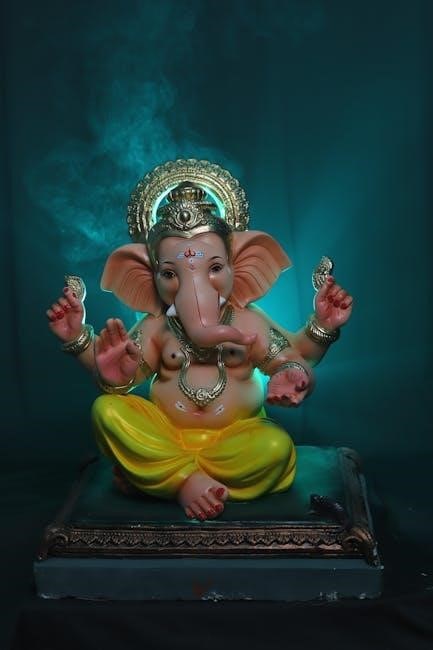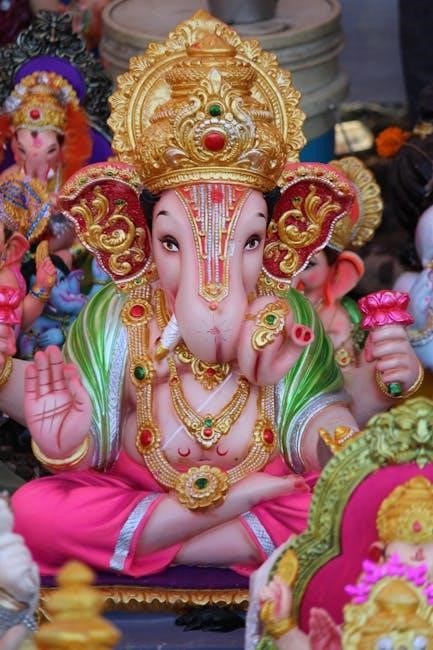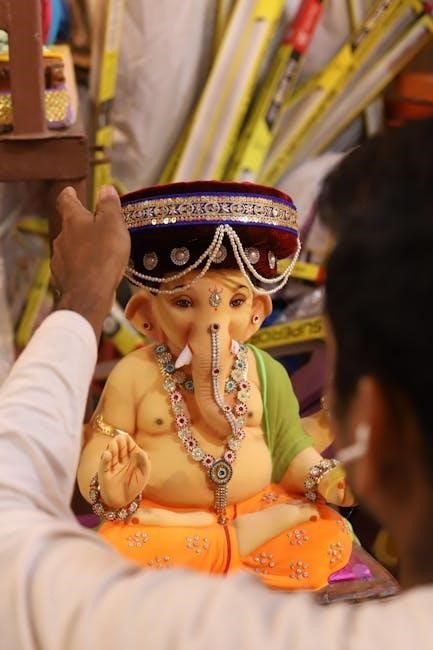William Golding’s Lord of the Flies is a thought-provoking novel set during a time of nuclear destruction, exploring human nature through stranded boys on a mysterious island․
1․1 Overview of the Novel
Lord of the Flies, written by William Golding, tells the story of a group of British boys stranded on a remote island after a plane crash․ With no adult supervision, the boys attempt to govern themselves, initially forming a utopian society․ However, their innocence and civility gradually erode, revealing primal instincts and savagery․ The novel explores themes of power, fear, and morality through characters like Ralph, Jack, and Piggy, while symbols such as the conch shell and the beast amplify the tension between order and chaos․ Golding’s gripping narrative examines humanity’s darker aspects․
1․2 Historical Context and Setting
Set during an unspecified time of nuclear destruction, Lord of the Flies takes place on a remote, uninhabited island where a group of British boys is stranded after a plane crash․ The novel’s setting, isolated from civilization, serves as a microcosm of society, allowing Golding to explore themes of human nature, power, and morality․ The absence of adult supervision creates a vacuum of authority, leading the boys to establish their own rules and social structures․ This backdrop of chaos and uncertainty amplifies the novel’s exploration of fear, savagery, and the breakdown of civility․
Major Themes in “Lord of the Flies”
The novel explores the nature of humanity, fear’s impact on behavior, and power dynamics, offering a profound commentary on society and human psychology․

2․1 The Nature of Humanity and Society
In Lord of the Flies, Golding explores the duality of human nature, revealing how civilization’s thin layer can be stripped away, exposing primal instincts․ The novel portrays society as a fragile construct, where moral decay emerges when rules and authority are absent․ The boys’ descent into chaos reflects Golding’s bleak view of humanity, suggesting that savagery is an inherent part of human nature, suppressed only by societal norms․ Their actions on the island mirror broader societal behaviors, highlighting the tension between order and anarchy, and the ease with which fear and violence can dominate human interactions․

2․2 Fear and Its Impact on Behavior
Fear plays a pivotal role in shaping the boys’ actions in Lord of the Flies, driving them toward paranoia and irrational behavior․ The mysterious “beast” becomes a symbol of their collective fear, causing division and hysteria․ As fear intensifies, the boys’ primal instincts dominate, leading to violence and savagery․ Fear also distorts their judgment, making them susceptible to manipulation, as seen in Jack’s exploitation of fear to gain power․ Golding illustrates how fear erodes morality and civility, revealing the darker aspects of human nature when societal constraints are removed․
2․3 Power Dynamics and Leadership
In Lord of the Flies, leadership becomes a focal point of conflict as the boys struggle to establish order․ Ralph, representing democracy, initially leads through shared values and fairness․ Jack, however, embodies authoritarianism, using fear and coercion to gain control․ The novel explores how leadership styles reflect societal structures, with Ralph’s civility contrasting Jack’s descent into tyranny․ The power struggle highlights the tension between collective good and individual ambition, ultimately leading to chaos․ Golding’s portrayal of these dynamics underscores the fragility of leadership and the ease with which power can corrupt even the most well-intentioned individuals․

Character Analysis
The novel delves into the psychological and moral journeys of its characters, exploring themes through Ralph’s civility, Jack’s savagery, Piggy’s intellect, Simon’s innocence, and the boys’ collective descent into chaos․

3․1 Ralph: The Symbol of Civilization
Ralph embodies the ideals of civilization and democracy, as he advocates for order, fairness, and the greater good․ His leadership is characterized by the use of the conch shell, which symbolizes equality and the right to speak․ Throughout the novel, Ralph’s struggle to maintain civility highlights the tension between humanity’s innate savagery and its capacity for moral order․ His character serves as a poignant reminder of society’s fragility and the importance of ethical leadership in preserving communal harmony․
3․2 Jack: The Embodiment of Savagery
Jack Merridew evolves from a choirboy to a ruthless leader, embodying humanity’s primal instincts․ His obsession with hunting symbolizes the descent into savagery, as he prioritizes power and control over civility․ Jack’s actions, such as painting his face and embracing violence, reflect his rejection of moral constraints․ His character serves as a stark contrast to Ralph’s civilized ideals, highlighting the inherent conflict between order and chaos․ Jack’s transformation underscores Golding’s exploration of how fear, ambition, and the absence of societal norms can unleash humanity’s darker tendencies․
3․3 Piggy: The Voice of Reason
Piggy, the intelligent and rational member of the group, represents logic and wisdom․ Despite his physical limitations, he provides strategic ideas and moral guidance․ His asthma and weight struggles make him an outcast, yet his intellect shines through․ Piggy’s reliance on the conch shell underscores his belief in democracy and order․ He often serves as the voice of reason, urging the boys to think critically and maintain civility․ His unwavering commitment to logic and justice highlights the importance of intellect in societal structures, making him a crucial moral compass amid the island’s chaos․
3․4 Simon: The Epitome of Innocence

Simon, a quiet and introspective boy, embodies innocence and kindness․ His gentle nature and deep connection to the island’s natural world set him apart․ Unlike others, Simon finds solace in solitude, often uncovering truths hidden to the group․ His discovery of the “Lord of the Flies” reveals the true nature of the beast, symbolizing the inherent evil within humanity․ Simon’s tragic fate underscores the loss of innocence and the destructive forces of fear and savagery, making him a poignant symbol of moral purity in the novel․
3․5 The Beast: A Symbol of Fear
The Beast, a mysterious entity feared by the boys, symbolizes the primal terror embedded in human psychology․ Initially believed to be a monster, it evolves into a representation of the inherent evil within humanity․ The boys’ fear of the Beast escalates tensions, driving their descent into chaos․ The Beast’s true nature—a seaweed-covered corpse—is revealed, yet the boys’ irrational fear persists, highlighting how fear can manifest into destructive behavior․ The Beast serves as a catalyst for the group’s savagery, illustrating the darker aspects of human nature when unchecked by civilization․
Symbolism in the Novel
Golding uses powerful symbols like the conch shell, the island, and the Lord of the Flies to explore themes of civilization, savagery, and the inherent evil in humanity․
4․1 The Conch Shell: A Symbol of Order
The conch shell is a potent symbol of order and democracy in the novel․ Found by Ralph, it is used to summon meetings and ensure only one boy speaks at a time․ This shell represents civilization and fairness, as it gives equal voice to all․ However, as the boys’ behavior becomes more savage, the conch’s power fades, symbolizing the erosion of order․ Its eventual destruction mirrors the collapse of their civilized society, highlighting the struggle between chaos and structure in human nature․
4․2 The Island: A Microcosm of Society
The island serves as a microcosm of society, reflecting human behavior in isolation․ Initially perceived as a paradise, it becomes a place of fear and savagery․ The boys’ actions mirror societal structures, with power struggles and hierarchies emerging․ The island’s transformation from a symbol of freedom to one of chaos underscores the novel’s themes of civilization versus savagery․ It becomes a testing ground for humanity’s inherent tendencies, revealing how quickly societal norms can crumble without external constraints․
4․3 The Lord of the Flies: A Symbol of Evil
The “Lord of the Flies” symbolizes evil, embodying the darkness within humanity․ The pig’s head, impaled on a stake and surrounded by flies, represents corruption and savagery․ It serves as a physical manifestation of the beast, which the boys fear․ Through this symbol, Golding illustrates how evil is not an external force but an inherent part of human nature․ The Lord of the Flies becomes a focal point of fear and temptation, revealing the boys’ descent into chaos and moral decay, highlighting the novel’s central theme of humanity’s capacity for evil․

The Novel’s Impact and Legacy
Lord of the Flies has become a cornerstone of educational curricula, sparking discussions on human nature and society․ Its exploration of fear and power dynamics continues to influence modern literature, solidifying its enduring popularity and relevance in understanding human behavior․
5․1 Critical Reception and Popularity
Lord of the Flies has garnered significant critical acclaim for its profound exploration of human nature and societal structures․ Its themes of fear, power, and savagery resonate deeply with audiences, making it a cornerstone of educational curricula worldwide․ The novel’s popularity endures, with its influence evident in modern literature and popular culture․ Critics praise its ability to provoke thought and spark discussions, solidifying its place as a timeless classic in 20th-century literature․
5․2 Influence on Modern Literature
Lord of the Flies has profoundly influenced modern literature, inspiring dystopian and speculative fiction․ Its exploration of human nature, power dynamics, and societal collapse resonates in works like The Hunger Games and Game of Thrones․ The novel’s themes of primal instincts and moral decay continue to shape contemporary authors’ narratives․ Its impact is also evident in educational curricula, where it remains a cornerstone for exploring complex ethical questions, ensuring its legacy endures as a foundational text in literary studies and popular culture alike․

Leave a Reply
You must be logged in to post a comment.